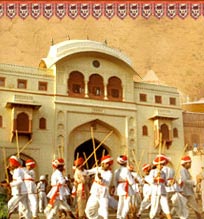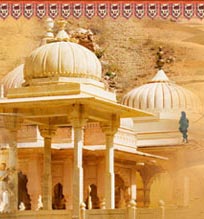 |
The Chittorgarh fort is a symbol of Rajput bravery and chivalry. Read about the Chittaurgarh fort in Rajasthan.
|
Chittorgarh Fort
The pride of Chittor, the Chittorgarh fort is a massive structure with many gateways. Perched on a 180 m high hill, it sprawls over 700 acres. The chhatris within are impressive reminders of the Rajput heroism. The main gates are Padal Pol, Bhairon Pol, Hanuman Pol and Ram Pol. The fort has many magnificent monuments, which are fine examples of the Rajput architecture. The ancient ruins of the fort are worth spending few moments in solitude.
The story of Chittorgarh is a saga of valor, tenacity and sacrifice. Chittorgarh (Chittaurgarh) was sacked three times and its defenders had to make the supreme sacrifice. The Fort of Chittorgarh is a treasure trove of history and offers to the traveler an insight into the life of the Great Rajput rulers, who laid down their lives fighting a superior enemy instead of leading a life of submission under them.
Chittorgarh is located in the southern part of the state of Rajasthan. It is located beside a high hill near the Gambheri River. It is 112 km from Udaipur and 182 km from Ajmer. The climate of Chittorgarh is arid. Summers are quite hot (April-June) and winters are cool (October-February). It experiences scant rainfall between June and August.
The origin of Chittorgarh can be traced to the seventh century. Earlier it was known as Chitrakut, after a local Rajput chieftain named Chitrang. It remained the capital of the local Sisodia clan of Rajputs from the eighth to the 16th century. The history of this town is written in blood and sacrifice. Muslim rulers sacked it three times in the medieval period. The first was by Ala-ud-din Khilji, the Sultan of Delhi in 1303. Khilji laid siege of this hill fort to capture the beautiful Padmini, the queen of Chittorgarh. When the situation worsened, Bhim Singh, the ruler of Chittorgarh, led his men donned with saffron robes of sacrifice, and rode out of the fort to certain death. Inside the fort, women, including Padmini and the children, committed mass suicide or jauhar by immolating themselves on a huge pyre, rather than losing their honor at the hands of the enemy.
In the middle of the 15th century, Chittorgarh gained eminence when the legendary Rajput ruler, Rana Kumbha, ruled it. He built the Vijay Stambh (Victory Tower) to commemorate his victory over Mahmud Khilji, the ruler of Malwa, in 1440. Chittorgarh was sacked again in 1535 by Bahadur Shah, the Sultan of Gujarat. The jauhar that followed the siege saw the death of 13,000 women and 32,000 Rajput soldiers. The third and final siege took place in 1568 at the hands of the great Mughal emperor Akbar. Jaimal and Kalla, two Rajput generals, valiantly defended the fort but with their death and deteriorating situation, jauhar was performed. However, Maharana Udai Singh II, the ruler of Chittorgarh, fled to Udaipur and re-established his rule. The Mughal emperor Jahangir returned Chittorgarh to its rulers in 1616.
The story of Chittorgarh is a saga of valor, tenacity and sacrifice. Chittorgarh (Chittaurgarh) was sacked three times and its defenders had to make the supreme sacrifice. The Fort of Chittorgarh is a treasure trove of history and offers to the traveler an insight into the life of the Great Rajput rulers, who laid down their lives fighting a superior enemy instead of leading a life of submission under them.
Chittorgarh is located in the southern part of the state of Rajasthan. It is located beside a high hill near the Gambheri River. It is 112 km from Udaipur and 182 km from Ajmer. The climate of Chittorgarh is arid. Summers are quite hot (April-June) and winters are cool (October-February). It experiences scant rainfall between June and August.
The origin of Chittorgarh can be traced to the seventh century. Earlier it was known as Chitrakut, after a local Rajput chieftain named Chitrang. It remained the capital of the local Sisodia clan of Rajputs from the eighth to the 16th century. The history of this town is written in blood and sacrifice. Muslim rulers sacked it three times in the medieval period. The first was by Ala-ud-din Khilji, the Sultan of Delhi in 1303. Khilji laid siege of this hill fort to capture the beautiful Padmini, the queen of Chittorgarh. When the situation worsened, Bhim Singh, the ruler of Chittorgarh, led his men donned with saffron robes of sacrifice, and rode out of the fort to certain death. Inside the fort, women, including Padmini and the children, committed mass suicide or jauhar by immolating themselves on a huge pyre, rather than losing their honor at the hands of the enemy.
In the middle of the 15th century, Chittorgarh gained eminence when the legendary Rajput ruler, Rana Kumbha, ruled it. He built the Vijay Stambh (Victory Tower) to commemorate his victory over Mahmud Khilji, the ruler of Malwa, in 1440. Chittorgarh was sacked again in 1535 by Bahadur Shah, the Sultan of Gujarat. The jauhar that followed the siege saw the death of 13,000 women and 32,000 Rajput soldiers. The third and final siege took place in 1568 at the hands of the great Mughal emperor Akbar. Jaimal and Kalla, two Rajput generals, valiantly defended the fort but with their death and deteriorating situation, jauhar was performed. However, Maharana Udai Singh II, the ruler of Chittorgarh, fled to Udaipur and re-established his rule. The Mughal emperor Jahangir returned Chittorgarh to its rulers in 1616.






